
Japan in May
May 1-5: Giant Kite Battle at Suwa Shrine
This particular festival goes back to 1550. Huge kites are flown by teams and each team tries the cut the cords of the other kites with their own kite.
May 3: Constitution Day
The Constitution of Japan came into force on May 3, 1947 leading to the annual celebration of the event. This constitution was written while the country was still under American occupation and reflects Western thinking in that it holds that sovereignty lies with the people and not the Emperor, and that people have fundamental human rights. It also renounces war.
On this day in Tokyo the Diet building is opened to the general public.
May 2nd or 3rd: Hachiju-hachiya
This is the celebration of the first day of spring. After this date frost almost never appears. The best time of the year to pick leaves that will be made into tea is also in the two to three week period after this celebration.
May 3rd and 4th: Hakata Dontaku Festival
The festival takes place in the city of Fukuoka in northern Kyushu and evolved from a folk art practiced during the Muromachi Period (1333-1568). It was at that time performed by farmers and townspeople as a New Year's greeting for the local landowner and/or leader. People dressed up as gods of good fortune and paraded to music.
Floats and platforms with dolls were added during the Edo Period (1600-1868).
May 5: Children's Day
This holiday was built on the foundation of an older Tango no Sekku observance which was on the fifth day of the fifth month and celebrated the male offspring of a family. Households flew colorful carp streamers, one for each sun. Miniature sets of armor and model warriors were displayed in the homes.

As the holiday it is today it was started in 1948 and now is to celebrate the healthy growth and happiness of children of both sexes.
Families also take baths on this day in water sprinkled with iris leaves and roots since the iris is thought to promote good health and ward off evil. Rice cakes wrapped in oak leaves and filled with sweet bean paste are also eaten on this day.
Second Sunday in May: Mother's Day
Carnations are given to Mothers on this day. It was first celebrated by Christians in Japan around 1913, grew considerably in the 1930's, was halted during World War II and was revived after the war.
Children will also buy their mothers gifts and help out with chores on this day.
May 15: Aui Festival
This is a festival held in Kyoto at the Kamigamo Shrine. It is dated back to the 8th century.
Some five hundred people dress up in ancient imperial court dress and have carriages pulled by oxen. There is a parade, a Shinto ritual and a private Imperial service.
May 14-16: Kanda Myojin Festival
This festival is held in Tokyo and is some 1400 years old. Many costumes of the Heian Period are worn during the parade.
3rd weekend of May: Sanja Festival
This is another Tokyo festival and became popular during the Edo Period (1600-1868). Various portable shrines are paraded about through crowded streets near the Asakusa Shrine. The portable shrines are not light, however, weighing perhaps up to a ton yet many people will vie with each other for the privilege of helping to carry the shrine.
Late May: Mid-term exams
Tests are usually given at this time in Japanese, mathematics, science, social studies and English. All extracurricular activities and clubs are canceled for a week before midterms to allow students time to prepare for the tests.
Each test is important to the students as the results on their tests end up determining what type of high school, college or university they can enter which itself largely determines what kind of job they will be able to get so competition on these exams is quite keen.

|